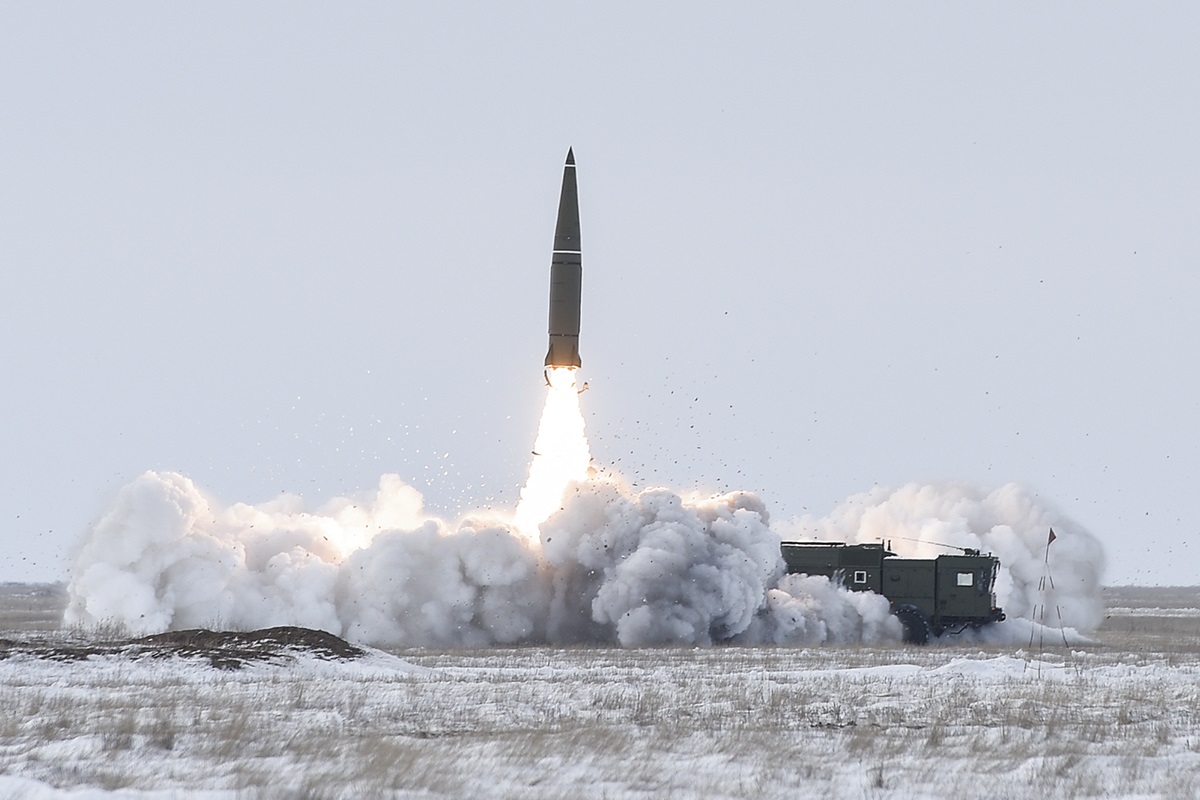The Iskander missile platform has been discussed in western military press circles for years now. But just how lethal is this missile? Here, we try to provide some clear answers: Russia’s 9K720 Iskander missile system is the most well-known system responsible for delivering Russia’s formidable ballistic missile arsenal. Otherwise known by its NATO identification SS-26 “Stone”, the Iskander is Russia’s most modern ballistic and cruise missile launcher in service today.
The Iskander is a road-mobile element of the Russian Armed Forces’ missile arsenal, and as such consists of the 9P78 Transporter-Erector Launcher and several 9M723 ballistic missiles in its basic “Iskander-M” configuration. With a crew of three people, each Iskander-M can carry two ballistic missiles. With a range of up to 500 kilometers, the 9M723 ballistic missile mounted on an Iskander is highly accurate, with a circular error probable (CEP) of two to five meters. The missile is propelled by a solid propellant, and can carry a payload weighing between 480 to 700 kilograms. In comparison, the “Iskander-K” variant can carry two 9M728 or four 9M729 cruise missiles.
Development on the Iskander first began in the first half of the 1970s to replace the Soviet Union’s Scud-B missile system. After years of development, the 9K720 Iskander became operational in 2006, when they were first acquired by the Russian military. Development of the Iskander system was initially expedited to replace the OTR-23 Oka ballistic missile system, which was due to be retired as part of the Soviet Union’s compliance with the Intermediate-Range Nuclear Forces (INF) Treaty. The Iskander was first test-fired in 1996, which was followed later in 2010 by tests of 9M723-1, an updated version of the system’s ballistic missile.
In addition to its value as a conventional ballistic missile system, the Iskander-M is nuclear capable, which has put the system under particular international scrutiny. Western intelligence and defense analysts are reportedly closely monitoring the movements and employment of Russian Iskander-Ms as part of Russia’s 2022 invasion of Ukraine to check for any warning signs that Moscow might be preparing to use nuclear weapons in Ukraine. Five Russian Iskander brigades were reportedly staged in Belarus and Russia’s Southern Military District in the opening stages of the war, although they have only launched conventional missiles to date. Prior to Russia’s 2022 invasion of Ukraine, the United States raised concerns and ultimately left the INF treaty over concerns that Iskander-K systems carrying 9M729 ground-launched cruise missiles was a violation of the terms of the 1987 INF treaty. Iskanders sent to the Russian exclave of Kaliningrad particularly raised concern in Western capitals, as they saw the presence of the missile system in Russia’s westernmost federal subject as a significant threat to their national security.
Iskanders reportedly remain an important element of Russia’s ongoing invasion of Ukraine and Russia’s posture towards other neighbors. According to the General Staff of the Ukrainian Armed Forces, Russia has positioned many Iskander-Ms near the border with Ukraine to support the invasion. In response to Finland’s decision to apply to join the NATO alliance, Russia has purportedly dispatched several Iskander launchers to the city of Vyborg in Karelia, near the Finnish border, in an apparent effort to pressure Helsinki. The weapon had also been used to some effect in Russia’s invasion of Georgia and its campaign in Syria.
In addition to its service with the Russian armed forces, the Iskander has been employed by the Algerian and Armenian armed forces. In 2016, Armenia was the first to receive the export version of the ballistic missile system – the Iskander-E. These were reportedly employed by Armenia against Azerbaijani forces in the 2020 Nagorno-Karabakh war. By the end of 2017, Algeria had followed suit and purchased a full brigade’s worth of the Iskander-E, making Algiers the system’s second customer.
Given its role as a versatile ballistic missile launcher that is also Russia’s most modern, the Iskander in both of its main configurations, will remain a significant element of the Russian Ground Forces’ arsenal.
Wesley Culp is a Research Fellow at the Center for the Study of the Presidency and Congress. He regularly writes on Russian and Eurasian leadership and national security topics and has been published in The Hill and the Diplomatic Courier. He can be found on Twitter @WesleyJCulp.

